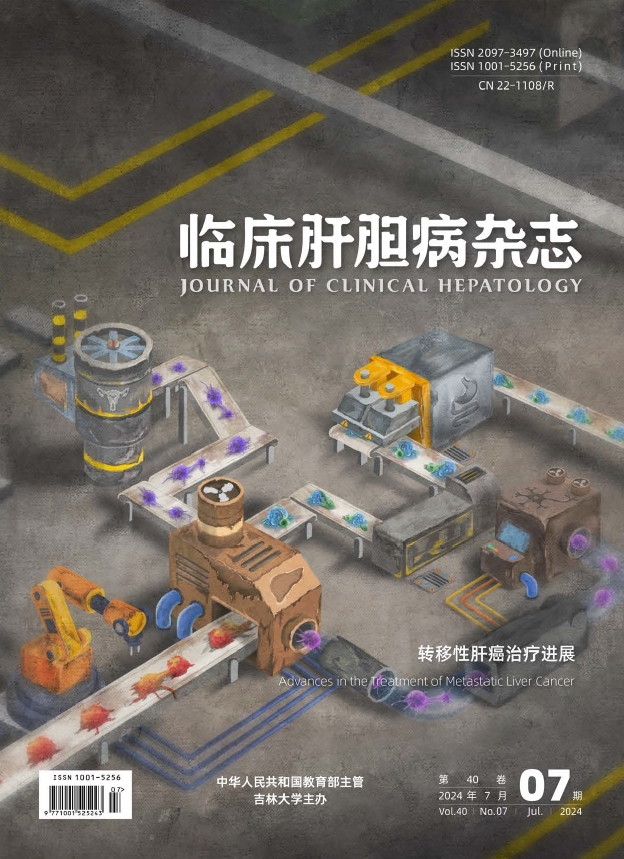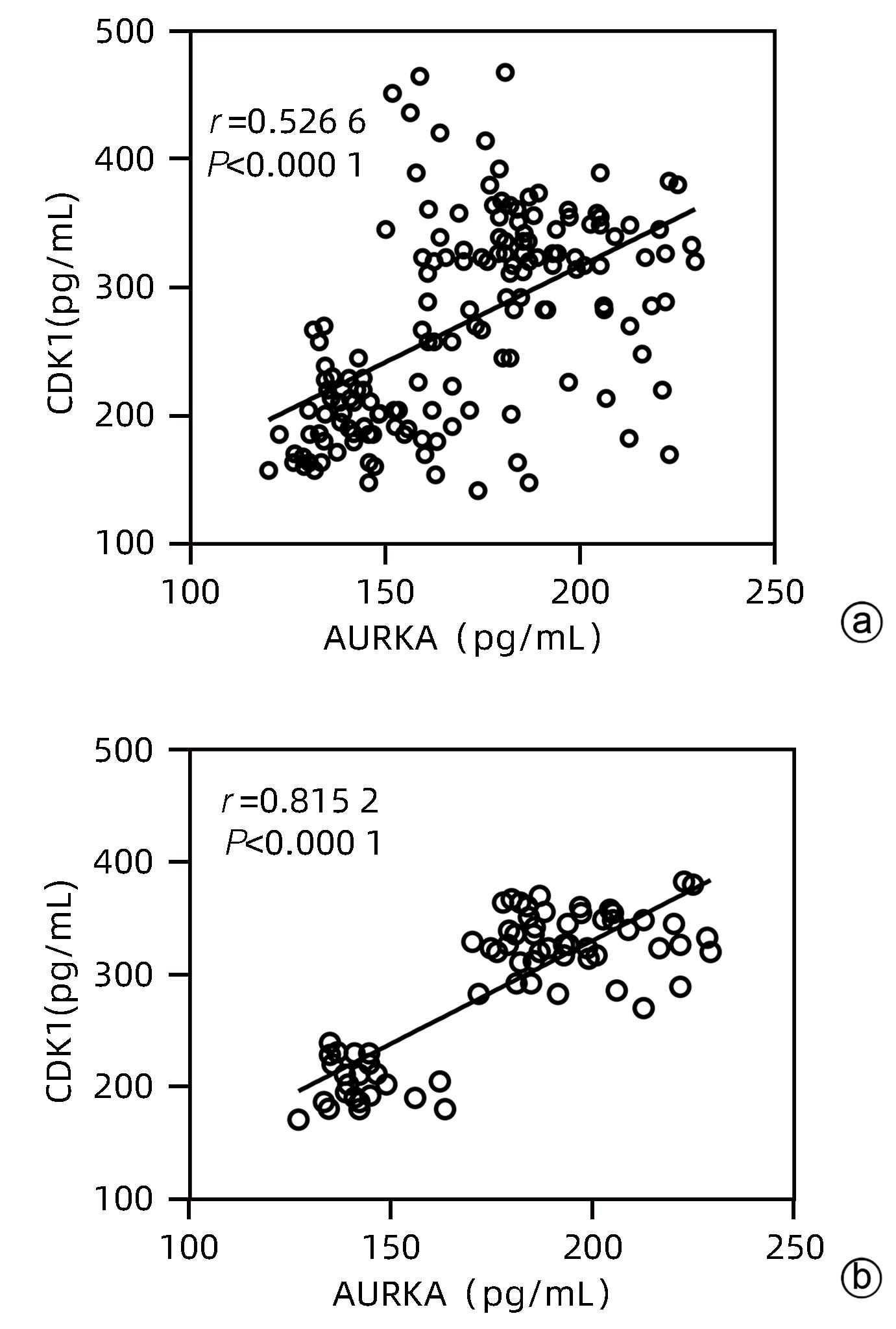| [1] |
BRAY F, FERLAY J, SOERJOMATARAM I, et al. Global cancer statistics 2018: GLOBOCAN estimates of incidence and mortality worldwide for 36 cancers in 185 countries[J]. CA Cancer J Clin, 2018, 68( 6): 394- 424. DOI: 10.3322/caac.21492. |
| [2] |
CHEDID MF, KRUEL CRP, PINTO MA, et al. Hepatocellular carcinoma: Diagnosis and operative management[J]. Arq Bras Cir Dig, 2017, 30( 4): 272- 278. DOI: 10.1590/0102-6720201700040011. |
| [3] |
CHEN DH, HONG M, ZHANG YL, et al. Expression and clinical significance of HBx and miR-122 in hepatitis B related hepatocellular carcinoma[J]. J Mol Diagn Ther, 2023, 15( 2): 240- 243, 248. DOI: 10.19930/j.cnki.jmdt.2023.02.029. |
| [4] |
ZHU HZ, ZHOU WJ, WAN YF, et al. Downregulation of orosomucoid 2 acts as a prognostic factor associated with cancer-promoting pathways in liver cancer[J]. World J Gastroenterol, 2020, 26( 8): 804- 817. DOI: 10.3748/wjg.v26.i8.804. |
| [5] |
HUANG YH, SRAMKOSKI RM, JACOBBERGER JW. The kinetics of G2 and M transitions regulated by B cyclins[J]. PLoS One, 2013, 8( 12): e80861. DOI: 10.1371/journal.pone.0080861. |
| [6] |
ZOU YP, RUAN SY, JIN L, et al. CDK1, CCNB1, and CCNB2 are prognostic biomarkers and correlated with immune infiltration in hepatocellular carcinoma[J]. Med Sci Monit, 2020, 26: e925289. DOI: 10.12659/MSM.925289. |
| [7] |
HANAHAN D, WEINBERG RA. Hallmarks of cancer: The next generation[J]. Cell, 2011, 144( 5): 646- 674. DOI: 10.1016/j.cell.2011.02.013. |
| [8] |
JENG YM, PENG SY, LIN CY, et al. Overexpression and amplification of Aurora-A in hepatocellular carcinoma[J]. Clin Cancer Res, 2004, 10( 6): 2065- 2071. DOI: 10.1158/1078-0432.ccr-1057-03. |
| [9] |
Bureau of Medical Administration, National Health Commission of the People’s Republic of China. Guidelines for diagnosis and treatment of primary liver cancer in China(2019 edition)[J]. J Clin Hepatol, 2020, 36( 2): 277- 292. DOI: 10.3969/j.issn.1001-5256.2020.02.007. |
| [10] |
Chinese Society of Hepatology, Chinese Medical Association. Chinese guidelines on the management of liver cirrhosis[J]. J Clin Hepatol, 2019, 35( 11): 2408- 2425. DOI: 10.3969/j.issn.1001-5256.2019.11.006. |
| [11] |
Chinese Society of Hepatology, Chinese Medical Association; Chinese Society of Infectious Diseases, Chinese Medical Association. Guidelines for the prevention and treatment of chronic hepatitis B(version 2022)[J]. Infect Dis Inf, 2023, 36( 1): 1- 17. DOI: 10.3969/j.issn.1007-8134.2023.01.01.. |
| [12] |
LI J, HAN X, YU XN, et al. Clinical applications of liquid biopsy as prognostic and predictive biomarkers in hepatocellular carcinoma: Circulating tumor cells and circulating tumor DNA[J]. J Exp Clin Cancer Res, 2018, 37( 1): 213. DOI: 10.1186/s13046-018-0893-1. |
| [13] |
MA CY, FU YL, ZHANG ZL, et al. The value of contrast-enhanced ultrasound in evaluating the efficacy of microwave ablation for hepatocellular carcinoma and predicting local recurrence[J]. Clin J Med Offic, 2023, 51( 8): 850- 853. DOI: 10.16680/j.1671-3826.2023.08.21. |
| [14] |
MALOV SI, MALOV IV, DVORNICHENKO VV, et al. Application of alpha-fetoprotein and osteopontin combination for early diagnosis of hepatocellular carcinoma associated with hepatitis C[J]. Klin Lab Diagn, 2019, 64( 10): 607- 612. DOI: 10.18821/0869-2084-2019-64-10-607-612. |
| [15] |
YU XP, YANG RY, HE ZM, et al. Establishment and validation of nomogram of cancer specific survival of patients with hepatocellular carcinoma with negative alpha fetoprotein based on SEER Database[J]. J Jilin Univ(Med Edit), 2024, 50( 1): 188- 197. DOI: 10.13481/j.1671-587X.20240123. |
| [16] |
PENG QZ, HAO JW, QIN Y, et al. Effect of DNA damage repair pathway mediated by AURKA on HepG2 of liver cancer cells[J]. Chongqing Med, 2021, 50( 1): 1- 7. DOI: 10.3969/j.issn.1671-8348.2021.01.001. |
| [17] |
ZHANG L, HUANG Y, LING JJ, et al. Screening and function analysis of hub genes and pathways in hepatocellular carcinoma via bioinformatics approaches[J]. Cancer Biomark, 2018, 22( 3): 511- 521. DOI: 10.3233/CBM-171160. |
| [18] |
BAO ZY, LU L, LIU XY, et al. Association between the functional polymorphism Ile31Phe in the AURKA gene and susceptibility of hepatocellular carcinoma in chronic hepatitis B virus carriers[J]. Oncotarget, 2017, 8( 33): 54904- 54912. DOI: 10.18632/oncotarget.18613. |
| [19] |
LIU C, ZHU XX, JIA YQ, et al. Dasatinib inhibits proliferation of liver cancer cells, but activation of Akt/mTOR compromises dasatinib as a cancer drug[J]. Acta Biochim Biophys Sin, 2021, 53( 7): 823- 836. DOI: 10.1093/abbs/gmab061. |
| [20] |
LI XC, XU WQ, KANG W, et al. Genomic analysis of liver cancer unveils novel driver genes and distinct prognostic features[J]. Theranostics, 2018, 8( 6): 1740- 1751. DOI: 10.7150/thno.22010. |
| [21] |
WANG LL, JIN XH, CAI MY, et al. AGBL2 promotes cancer cell growth through IRGM-regulated autophagy and enhanced Aurora A activity in hepatocellular carcinoma[J]. Cancer Lett, 2018, 414: 71- 80. DOI: 10.1016/j.canlet.2017.11.003. |
| [22] |
CHEN CL, SONG GY, XIANG J, et al. AURKA promotes cancer metastasis by regulating epithelial-mesenchymal transition and cancer stem cell properties in hepatocellular carcinoma[J]. Biochem Biophys Res Commun, 2017, 486( 2): 514- 520. DOI: 10.1016/j.bbrc.2017.03.075. |
| [23] |
GOOS JACM, COUPE VMH, DIOSDADO B, et al. Aurora kinase A(AURKA) expression in colorectal cancer liver metastasis is associated with poor prognosis[J]. Br J Cancer, 2013, 109( 9): 2445- 2452. DOI: 10.1038/bjc.2013.608. |
| [24] |
TANG AQ, GAO KY, CHU LL, et al. Aurora kinases: Novel therapy targets in cancers[J]. Oncotarget, 2017, 8( 14): 23937- 23954. DOI: 10.18632/oncotarget.14893. |
| [25] |
ZHANG LJ, SHI H, JIANG ZY, et al. The mechanism of AURKA regulation of tumor cisplatin resistance[J]. Chem Life, 2023, 43( 8): 1268- 1276. DOI: 10.13488/j.smhx.20220609. |
| [26] |
WU CX, WANG XQ, CHOK SH, et al. Blocking CDK1/PDK1/β-Catenin signaling by CDK1 inhibitor RO3306 increased the efficacy of sorafenib treatment bytargeting cancer stem cells in a preclinical model of hepatocellular carcinoma[J]. Theranostics, 2018, 8( 14): 3737- 3750. DOI: 10.7150/thno.25487. |
| [27] |
TANG WW, CHEN ZY, ZHANG WL, et al. The mechanisms of sorafenib resistance in hepatocellular carcinoma: Theoretical basis and therapeutic aspects[J]. Signal Transduct Target Ther, 2020, 5( 1): 87. DOI: 10.1038/s41392-020-0187-x. |
| [28] |
YAN M, BAI RX, CHENG S, et al. Expression and significance of cyclin-dependent kinase 1 in human colorectal cancer[J]. Chin J Clin Dr, 2021, 49( 9): 1080- 1082. DOI: 10.3969/j.issn.2095-8552.2021.09.021. |
| [29] |
FANG XT, WU YY, YU TT, et al. Fusobacterium nucleatum promotes colorectal cancer by up-regulating Cdk1 through intestinal metabolite sodium butyrate[J]. Chin J Cell Biol, 2021, 43( 5): 979- 990. DOI: 10.11844/cjcb.2021.05.0009. |
| [30] |
NOZOE T, TAKAHASHI I, BABA H, et al. Relationship between intracellular localization of p34cdc2 protein and differentiation of esophageal squamous cell carcinoma[J]. J Cancer Res Clin Oncol, 2005, 131( 3): 179- 183. DOI: 10.1007/s00432-004-0607-2. |
| [31] |
MA XL, HUANG SH, HUANG JA, et al. Expression and significance of CyclinB1 and CDK1 in gastric cancer[J]. Chin J Curr Adv Gen Surg, 2004, 7( 5): 272- 274. DOI: 10.3969/j.issn.1009-9905.2004.05.007. |
| [32] |
SU Y, PAN SJ, LI ZQ, et al. Multiplex imaging and cellular target identification of kinase inhibitors via an affinity-based proteome profiling approach[J]. Sci Rep, 2015, 5: 7724. DOI: 10.1038/srep07724. |
| [33] |
MALUMBRES M, BARBACID M. Cell cycle, CDKs and cancer: A changing paradigm[J]. Nat Rev Cancer, 2009, 9( 3): 153- 166. DOI: 10.1038/nrc2602. |








 DownLoad:
DownLoad:

